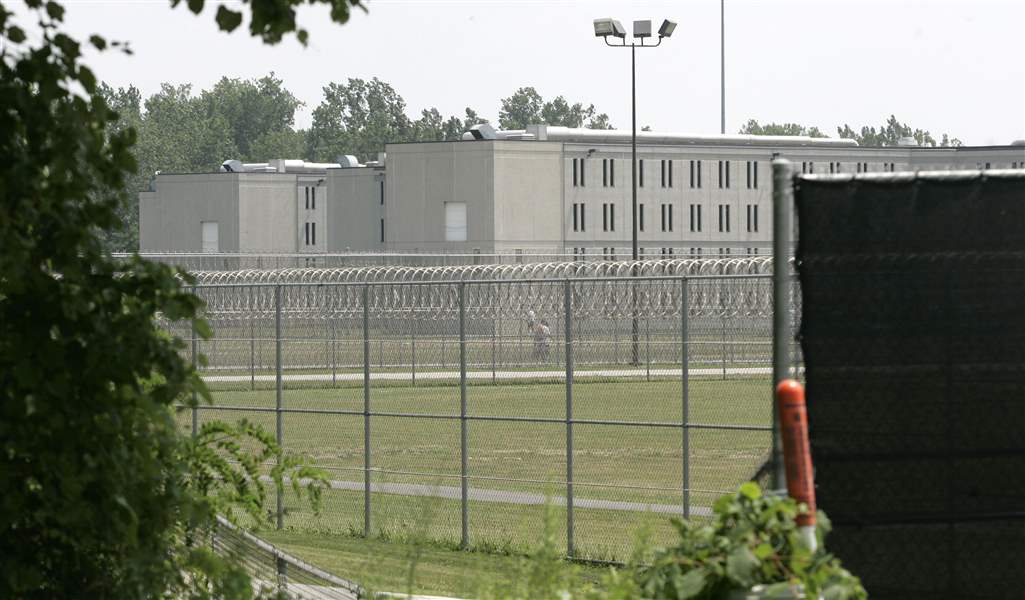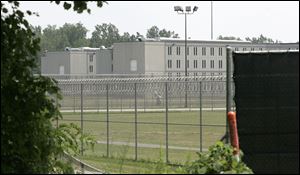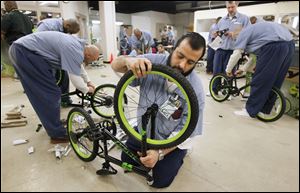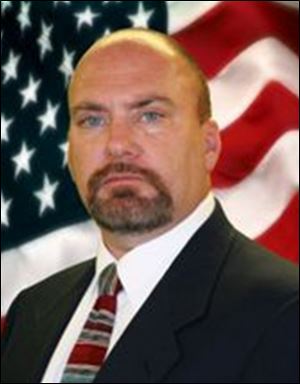
COMMENTARY
State moves to reduce local prison crowding
Chief rightly opposes building more facilities
10/20/2013
Designed for only 900 inmates, Toledo Correctional Institution now holds 1,263. Ohio’s systemwide population — 50,317 — is 30 percent above capacity.
THE BLADE
Buy This Image
In an encouraging but overdue move to reduce violence at Toledo Correctional Institution, the state has stopped sending inmates to the Toledo prison, effective Thursday, Warden Ed Sheldon told me Thursday during a tour of the prison. The move will reduce TCI’s population by about 40 inmates a month and decrease double-bunking. In addition, the state has already reduced the security levels of 60 TCI prisoners and will move them to other prisons.
During a 90-minute interview at the prison, Gary Mohr, director of the Ohio Department of Rehabilitation and Correction, said he’s committed to reducing population and double-bunking at TCI, adding staff, and expanding programs, including visitation.
But many of Ohio’s 28 prisons are crowded. The systemwide population — 50,317 — is 30 percent above capacity. And for more than a year, it has continued to rise. If current trends continue, the director said, the population will become unmanageable by July, 2015.
Still, Mr. Mohr rightly opposes building more prisons, suggesting that he would resign if that’s the direction Ohio takes. Instead, he wants to manage the population through, among other things, smart sentencing reforms, community alternatives to incarceration for nonviolent offenders, and shorter but more intense prison stays for certain probation and parole violators. Nearly 45 percent of the more than 20,000 people a year who come to prison in Ohio serve less than a year.

Jeff Gerritt.
“If we don’t stop this trend of population,” he told me, “I will have to build, and then they’ll replace me as director because I will have failed. I will step down.”
TCI has reported an appalling four fatal assaults on prisoners in the last 13 months. To put that in focus, in neighboring Michigan, the entire state prison system had two such prisoner deaths in the last seven years.

Gary Mohr, director of the Ohio Department of Rehabilitation and Correction, says he’s committed to reforms at the Toledo Correctional Institution.
The right ideas
In rejecting more prisons and advocating sentencing and program reforms, Mr. Mohr has the right ideas for reducing crowding and idleness in the state’s mammoth prison system, but some of them take time and the immediate crisis at the Toledo prison could derail them.
If Ohio builds more prisons, it will find a way to fill them. And once they’re built, they become, politically, almost impossible to close, whether they’re needed or not, because communities view them as employment agencies.
No doubt, Mr. Mohr will take some static from the tough-on-crime crowd for opposing more prisons. But in debating correction policies, Ohioans should drop the labels: tough, soft, liberal, conservative, Republican, Democrat. They just jack up people’s emotions and blind them.
What matters in this debate is what policies and programs work, and what approaches don’t. And what Ohio and the rest of the country have done over the past 40 years with prisons and corrections has failed miserably.
Driven by mandatory minimum sentences and other such measures, prison populations have quadrupled over the past 40 years, sucking state coffers dry and tearing up communities, without affecting crime rates. Ohio now spends $1.5 billion a year on prisons. Michigan spends $2 billion — more than it spends on higher education.

Designed for only 900 inmates, Toledo Correctional Institution now holds 1,263. Ohio’s systemwide population — 50,317 — is 30 percent above capacity.
A vow to change
Talking to Mr. Mohr can leave one dizzy. He spits ideas like an AK-47 with a Hellfire trigger and approaches his job with missionary zeal.
“I came in with a commitment that we’re going to change,” he told me. “Quite frankly, I’ve worn some people out. But life is short. We’re in these roles for fleeting moments and, by God, we better do something while we’re here.”
In the nearly three years he’s been on the job, Mr. Mohr has done plenty, doubling so-called therapeutic communities for drug dependent inmates, putting counselors and case managers back in units with inmates and officers, and expanding re-entry coalitions. He has reorganized state prisons into a tiered system, based on control levels, that separate disruptive, high-risk inmates from other prisoners.
“Evidenced-based” is his mantra. He wants programs with proven results. In Mr. Mohr’s tenure, recidivism rates have dropped to a record low 28.7 percent. Statewide, violent incidents have gone down, but TCI’s four homicides have eclipsed that.
The prisoners responsible for three of the four homicides were lower-security — level 3, or close security — inmates who were among the 1,000 TCI prisoners who are double-bunked. Only one of the killers was among the 220 maximum-security inmates at TCI who are single-bunked. The victim in that case, Arturo Lopez, 43, was strangled in his cell with a rope in March. The Ohio Highway Patrol determined that three of the four deaths were not gang-related. One is still under investigation.
Mr. Mohr and Mr. Sheldon want to expand programs at TCI, but the prison was built as a high-security prison, with little space for programs and recreation. To add recreation space, Mr. Sheldon had a basketball court and track built inside a small courtyard last year.

In December, 2012, Yousser Ramadan, center, and other inmates assemble bicycles for children served by Lucas County Children Services. The Toledo prison offers inmates a chance to take on community service projects.
Lack of space
Designed for only 900 inmates, TCI now holds 1,263. When it opened in 2000, each inmate had his own cell. By 2011, the population had risen to more than 1,600. Double-bunking was followed by spikes in assaults.
Inmate Kevin Green, 42, of Youngstown, serving a life sentence for murder, sees a direct link between the crowding and violence.
“There’s no space, no privacy,” he told me. “We don’t have enough classrooms to accommodate the guys who want to go to school. We don’t have the space to accommodate programs like anger management, or the guys who need to learn about self worth, pride, and integrity. The waiting lists are long.”
The problem is especially bad for inmates with a lot of time left on their sentences, he said, because prisoners nearing release take priority. To help, Mr. Green started a fitness program for overweight inmates called Step It Up.
Prison employees also warned a year ago that crowding would lead to violence. Their union even bought billboard space to get the message out. “We saw the storm coming but it fell on deaf ears,” said Derek Urban, staff representative for the Ohio Civil Service Employees Association.

Warden Ed Sheldon calls the deaths at Toledo Correctional horrific, and says the experience has taken a personal toll.
Starting programs
To reduce idle time, Mr. Sheldon has encouraged inmates, under staff supervision, to start and run programs. At TCI, I met about a dozen inmate program aides. One ran a substance-abuse recovery group that made a DVD on drunken driving that’s now used in schools; one taught basic legal skills. The president of the prison’s NAACP program chapter ran a group on nurturing respect. Another taught Spanish, Arabic, and French. One inmate, who served in Iraq, headed a veterans’ group, and one worked with the prison’s green and recycling initiatives. Another started a support group for gay inmates.
Some inmates take on community service projects. In one room, I talked to two inmates who were rebuilding old and discarded bikes that would go to poor kids in the community. In another room, two inmates were making mats for the homeless and teddy bears for children in domestic abuse shelters.
Projects like these not only help the community but also build inmates’ pride and self-respect.
Mr. Sheldon said he needs volunteer skilled laborers, such as carpenters and plumbers, to teach inmates. But TCI will also need a lot more help from the state to reduce idleness and prepare inmates for life outside the walls, including more teachers for basic education and vocational training.
The jolt of violence
As we walked through the prison, Mr. Sheldon casually greeted staff and inmates. The visiting room looked lively and inmates were eating in the chow hall. TCI seemed much like any of the nearly 50 prisons I’ve visited in Michigan, Wisconsin, and other states. But as a newcomer to Toledo, this is the first prison I’ve visited in Ohio, and the first with four homicides in just over a year.
Mr. Sheldon called the deaths horrific, and the experience has taken a personal toll.
“When I took the job I understood that I could go anytime, and I’m satisfied with what I’ve done,” he told me. “My biggest fear is embarrassing the state of Ohio. I’ve said a million times that, if I’m no longer effective, I need to be replaced.”
But Mr. Mohr fully backs the warden and said that, if anyone should take heat, it should be the DRC director. “I believe in that guy,” he told me.
When Mr. Sheldon came in 2011, TCI housed more than 1,600 inmates. I asked him what’s an ideal number of inmates for the prison.
“None,” he said, after a pause.
That won’t happen, at least not for a long time. But the crisis at TCI is tied to the crowding of the state’s entire prison system.
The choice is stark: Ohio can either take sensible and safe steps to reduce its prison population, while providing meaningful opportunities for inmates to change, or it can continue a costly and futile race to incarcerate, warehousing more people in increasingly crowded and dangerous prisons, then spitting them out, unprepared for anything but a life of more crime.
Some politicians will use the crisis at TCI to push another prison-building boom that will bankrupt the state and make our communities less safe.
Gary Mohr has a better idea. We can either listen to reason or continue to follow the policies and practices that have taken us to this dangerous place.
Jeff Gerritt is deputy editorial page editor of The Blade.
Contact him at: jgerritt@theblade.com, 419-724-6467, or follow him on Twitter @jeffgerritt.